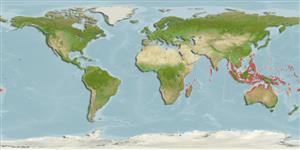Common names from other countries
>
Kurtiformes (Nurseryfishes, cardinalfishes.) >
Apogonidae (Cardinalfishes) > Apogoninae
Etymology: Fibramia: Latin 'fibra' meaning thread or filament and the feminine Greek 'amia' often applied as an ending for some cardinalfish genera as well as an incorrect past usage as a cardinalfish genus. The name refers to two characteristics of the species in this genus, an elongate second dorsal spine in one species and the narrow, pale or dark mid-line on the body of two species..
More on author: Valenciennes.
Issue
Generic placement confirmed by T. Fraser (pers.comm. 06/2011).
Environment: milieu / climate zone / depth range / distribution range
Écologie
marin; eau douce; saumâtre récifal; non migrateur (Ref. 59012); profondeur 0 - 3 m (Ref. 86942). Tropical; 26°N - 25°S, 32°E - 172°E
Indo-Pacific: East Africa to Tonga, north to Japan; Mariana and Caroline islands in Micronesia; south to Lord Howe Island (Ref. 9710).
Taille / Poids / Âge
Maturity: Lm ? range ? - ? cm
Max length : 11.0 cm TL mâle / non sexé; (Ref. 9710)
Épines dorsales (Total): 7; Rayons mous dorsaux (Total): 9; Épines anales 2; Rayons mous anaux: 8.
A euryhaline species (Ref. 59012), often found in freshwater and estuaries (Ref. 4329), shallow sheltered inshore reefs or river mouths, among clumps of algae or algal covered rubble. Found in aggregations (Ref. 9710).
Life cycle and mating behavior
Maturité | Reproduction | Frai | Œufs | Fécondité | Larves
Mouthbrooders (Ref. 240). Distinct pairing during courtship and spawning (Ref. 205).
Mabuchi, K., T.H. Fraser, H. Song, Y. Azuma and M. Nishida, 2014. Revision of the systematics of the cardinalfishes (Percomorpha: Apogonidae) based on molecular analyses and comparative reevaluation of morphological characters. Zootaxa 3846(2):151-203. (Ref. 96888)
Statut dans la liste rouge de l'IUCN (Ref. 130435)
CITES (Ref. 128078)
Not Evaluated
Menace pour l'homme
Harmless
Utilisations par l'homme
Plus d'informations
RéférencesAquacultureProfil d'aquacultureSouchesGénétiqueElectrophoresesHéritabilitéPathologiesTraitementMass conversion
Outils
Articles particuliers
Télécharger en XML
Sources Internet
Estimates based on models
Preferred temperature (Ref.
115969): 25.6 - 29.3, mean 28.6 (based on 2233 cells).
Phylogenetic diversity index (Ref.
82804): PD
50 = 0.6250 [Uniqueness, from 0.5 = low to 2.0 = high].
Bayesian length-weight: a=0.01230 (0.00732 - 0.02067), b=3.03 (2.89 - 3.17), in cm Total Length, based on LWR estimates for this species & (Sub)family-body (Ref.
93245).
Niveau trophique (Ref.
69278): 4.0 ±0.60 se; based on food items.
Résilience (Ref.
120179): Haut, temps minimum de doublement de population inférieur à 15 mois (Preliminary K or Fecundity.).
Fishing Vulnerability (Ref.
59153): Low vulnerability (10 of 100).
